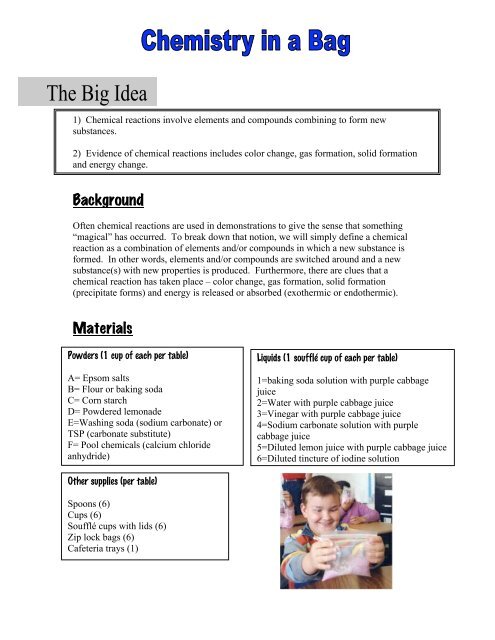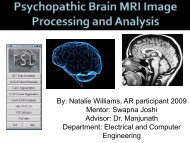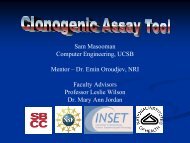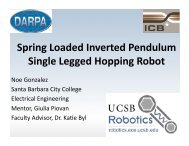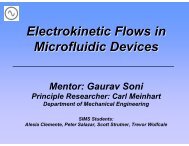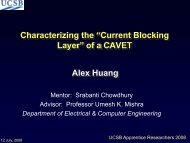Create successful ePaper yourself
Turn your PDF publications into a flip-book with our unique Google optimized e-Paper software.
1) Chemical reactions <strong>in</strong>volve elements and compounds comb<strong>in</strong><strong>in</strong>g to form new<br />
substances.<br />
2) Evidence of chemical reactions <strong>in</strong>cludes color change, gas formation, solid formation<br />
and energy change.<br />
Background<br />
Often chemical reactions are used <strong>in</strong> demonstrations to give the sense that someth<strong>in</strong>g<br />
“magical” has occurred. To break down that notion, we will simply def<strong>in</strong>e a chemical<br />
reaction as a comb<strong>in</strong>ation of elements and/or compounds <strong>in</strong> which a new substance is<br />
formed. In other words, elements and/or compounds are switched around and a new<br />
substance(s) with new properties is produced. Furthermore, there are clues that a<br />
chemical reaction has taken place – color change, gas formation, solid formation<br />
(precipitate forms) and energy is released or absorbed (exothermic or endothermic).<br />
Materials<br />
Powders (1 cup of each per table)<br />
A= Epsom salts<br />
B= Flour or bak<strong>in</strong>g soda<br />
C= Corn starch<br />
D= Powdered lemonade<br />
E=Wash<strong>in</strong>g soda (sodium carbonate) or<br />
TSP (carbonate substitute)<br />
F= Pool chemicals (calcium chloride<br />
anhydride)<br />
Liquids (1 soufflé cup of each per table)<br />
1=bak<strong>in</strong>g soda solution with purple cabbage<br />
juice<br />
2=Water with purple cabbage juice<br />
3=V<strong>in</strong>egar with purple cabbage juice<br />
4=Sodium carbonate solution with purple<br />
cabbage juice<br />
5=Diluted lemon juice with purple cabbage juice<br />
6=Diluted t<strong>in</strong>cture of iod<strong>in</strong>e solution<br />
Other supplies (per table)<br />
Spoons (6)<br />
Cups (6)<br />
Soufflé cups with lids (6)<br />
Zip lock bags (6)<br />
Cafeteria trays (1)
Procedure<br />
Prepared before the session: (Note- this part is prepared ahead of time by the FUSE<br />
Coord<strong>in</strong>ator)<br />
1. Purple cabbage juice is an acid-base <strong>in</strong>dicator made by cutt<strong>in</strong>g up cabbage <strong>in</strong>to 1 cm<br />
square pieces, cover<strong>in</strong>g with water, then boil<strong>in</strong>g (or microwav<strong>in</strong>g) until the liquid has<br />
most of the color. Purple cabbage juice is red <strong>in</strong> acid, purple when neutral, and as it gets<br />
more basic it is blue then green then yellow.<br />
2. Liquids are mixed and poured <strong>in</strong>to soufflé cups so that each is a different color and are<br />
labeled by number (you can also write the <strong>in</strong>gredients or <strong>in</strong>clude a legend). Keep these at<br />
the front of the room as they will be handed out to families later <strong>in</strong> the activity.<br />
3. Powders are <strong>in</strong> cups and are labeled by letter (you can also write the <strong>in</strong>gredients or<br />
<strong>in</strong>clude a legend). Place one of each, with a spoon, on a tray at each table. Also place<br />
ziplock bags at each table.<br />
Dur<strong>in</strong>g session<br />
1. Give an example of a physical reaction from everyday life (e.g. ice melt<strong>in</strong>g). Ask<br />
families what other physical reactions they can th<strong>in</strong>k of (if a chemical reaction is brought<br />
up, use it as an example <strong>in</strong> step 2).<br />
2. Give an example of a chemical reaction from everyday life (e.g. toast<strong>in</strong>g bread). Ask<br />
families what other chemical reactions they can th<strong>in</strong>k of. Discuss the differences between<br />
physical and chemical reactions and try to elicit as many of the families’ ideas as possible<br />
(ask lots of questions).<br />
3. Expla<strong>in</strong> that families will now be do<strong>in</strong>g their own reactions. Ask for ideas of evidence<br />
from the activity that will give them more <strong>in</strong>formation about the reaction tak<strong>in</strong>g place<br />
(what they might observe).<br />
4. Have each group open a zip lock bag and add one teaspoon of any powder and another<br />
teaspoon of a different powder to their bag. (The powders will be <strong>in</strong> cups on a tray at<br />
each table)<br />
5. Wait until each group has completed the above and <strong>in</strong>struct them to select a cup<br />
conta<strong>in</strong><strong>in</strong>g liquid (about ½ oz) from a tray that you br<strong>in</strong>g around. Have them place the<br />
cup <strong>in</strong>to the bag with the lid off but still upright and zip the bag tight, squeez<strong>in</strong>g out as<br />
much air as possible. Ask them to record which powders and liquids they selected. Wait<br />
until each person has placed a soufflé cup of liquid <strong>in</strong>to their bag, without lett<strong>in</strong>g the<br />
liquid and powder mix, before cont<strong>in</strong>u<strong>in</strong>g.
6. When everyone is ready, have them gently shake the bag and mix the liquid with the<br />
powders. Ask the families to observe what changes occur and discuss these with others at<br />
their table.<br />
7. Ask the families whether a chemical reaction had taken place and if so how they knew<br />
it had taken place, what evidence they were able to observe. Write the evidence they<br />
describe on the board and ask questions until a list is generated that <strong>in</strong>cludes: gas<br />
formation, color change, solid formation and energy is released (exothermic) or absorbed<br />
(endothermic) <strong>in</strong> the form of heat. (If not all of these are observed, try to have them th<strong>in</strong>k<br />
of the possibilities or expla<strong>in</strong> them and add them to the list).<br />
8. Ask families to use their evidence to f<strong>in</strong>d patterns about the reactions. Ask them which<br />
comb<strong>in</strong>ations of powders and liquids seem to create which type of reactions. (e.g. bak<strong>in</strong>g<br />
soda, calcium chloride, and cabbage juice release energy <strong>in</strong> the form of heat). Have a fun<br />
discussion about the different types of chemical reactions.<br />
Reactions<br />
Acid + base → neutral last (as long as equal amounts of acid and base are used)<br />
Acid + carbonate → H 2 CO 3 (carbonic acid) → H 2 O + CO 2 (gas) BUBBLES AND<br />
FIZZES!<br />
I 2 + I - + starch → iod<strong>in</strong>e-starch complex (dark blue)<br />
Exothermic reactions (these get hot)<br />
Endothermic reactions (these get cold)<br />
Resources<br />
http://www.csupomona.edu/~ceemast/science/scienceLessonPlans.htm<br />
http://www.buzzle.com/articles/chemical-reactions-<strong>in</strong>-everyday-life.html<br />
http://www.omsi.edu/chemunit2


